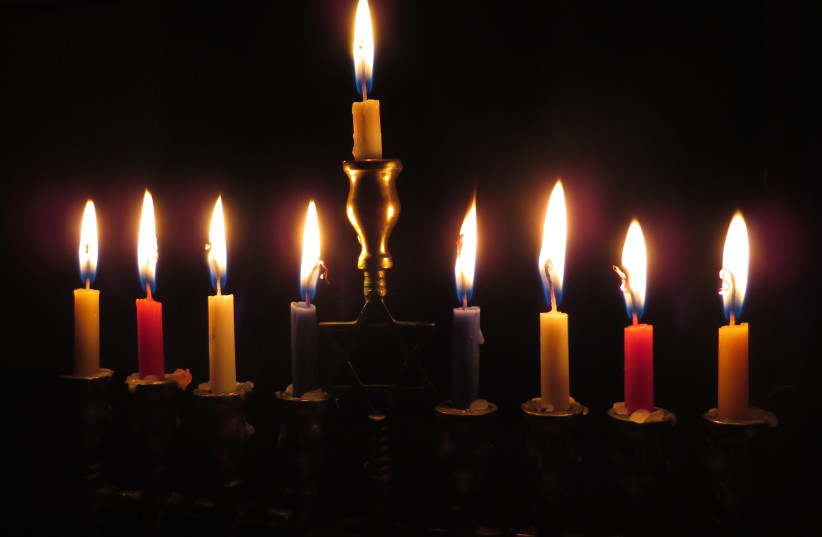This past week we entered the Hebrew month of Kislev, the month here in the Northern Hemisphere when we often experience the longest, darkest nights of the year. As the light contracts each day, I experience a tightening in my gut, an anxious fluttering of the heart. Time feels compressed, as if there aren’t enough hours in a day to do everything that needs doing. When the light fades at the end of these foreshortened days, I draw the blinds and turn on the lamps, wanting to make my home into an island of warmth and light in the face of the encroaching darkness.
My trepidation at the onset of night echoes the primal fear of the dark ascribed to the first mythic humans, Adam and Eve. A talmudic tale, found in Avodah Zarah 8a, imagines the two of them becoming frantic as darkness falls at the close of the first day of their lives. They’ve disobeyed God by eating from the Tree of the Knowledge of Good and Evil and now they’re terror stricken. “Woe is me,” Adam wails, “that because I’ve sinned, the world is darkening around me! The world will return to chaos and emptiness; this is heaven’s death sentence upon me!”
In this midrash, Adam experiences the arrival of darkness as punishment. His words conjure up the kind of existential shudder that can overtake a person in the dark, as the familiar shapes and colors of the daytime world dissolve into the trackless night. No wonder that darkness is often a metaphor for the scariest of times, times like the present, when awash in grief, fear and anger, we bear witness to the atrocities of war, to hatred unleashed and suffering magnified, to shattered dreams and dampened hopes. “These are dark times,” we tell one another.
Perhaps it’s only natural that humans try to beat back the dark with our hearths, campfires and brilliant winter light displays. We Jews do this beginning on the 25th of Kislev, when we kindle Hanukkah candles in remembrance of the Hasmoneans’ military victory over the Seleucid Greeks and the rededication of the Jerusalem Temple. But on a more primal level, we do this to remind ourselves that even a tiny flame instantly dispels the deepest dark, offering hope, a light at the end of the tunnel.

Light in the darkness
And yet it strikes me that many of our tradition’s most transformational and transcendent moments unfold in the dark, in a dream space rich with spiritual potency. In Toldot, this week’s Torah portion, for instance, we meet Jacob, whose journey toward self-realization is bookended by two stirring night episodes.
Fleeing from his wrathful brother, he has a prophetic dream in which angels ascend and descend a ladder stretching between heaven and earth while God looms over him, promising protection. Returning home some 20 years later, he engages in an all-night wrestling match with a mysterious being, perhaps his own shadow self, who ultimately blesses him as the dawn breaks, renaming him Israel, the one who strives with God and prevails.
Despite the anguish that darkness evokes, the dark times offer unique opportunities. They slow us down, inviting us to rest in the moment. Sometimes they force us to face painful truths. They challenge us to deepen our prayer life, strengthen our faith and resolve, and discover inner resources and possibilities for transformation we might not know we possess.
Years ago, I practiced walking in the woods at night without a flashlight and discovered that when I could breathe deeply and relax into the darkness, over time my eyes would adjust and I could see much more than I thought possible. Not just my eyes, but my whole body began to see in the dark in ways that I couldn’t in the light of day. I could find my way.
Adam and Eve, so the story goes, sat across from one another on that first traumatic night, fasting and weeping. When the dawn finally broke, they realized that the freshly created world was not coming to an end and that the alternation of light and dark, day and night, was simply the way of the world.
Had they not felt so guilty and terrified they might have been able to look around with curiosity as the light waned, noticing how their eyes were primed to pick up many subtle shades of gray, the palette of darkness. Their vision might have gradually adjusted to the dark and, in the subtle glow of starlight, they might have been able to pick out the familiar, reassuring features of the other’s face and been calmed and comforted, even in the midst of their distress.
Could it be that in our yearning for the resurgence of the light, we fail to recognize and fully receive the gifts of darkness? That in drawing my blinds against the terrors of the night, I also shut out the vastness of the cosmos, the glimmering pinpoints of distant stars, the radiant winter moon, and the intimate, enveloping quiet of the dark?
The views and opinions expressed in this article are those of the author and do not necessarily reflect the views of JTA or its parent company, 70 Faces Media.
